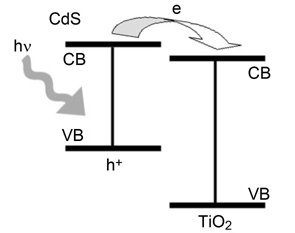| [1] O’Regan, B.; Grätzel, M. Nature 1991, 353, 737.[2] Law, M.; Sirbuly, D.; Johnson, J.; Goldberger, J.; Saykally, R.; Yang, P. Science 2004, 305, 1269.[3] Liu, Z.; Han, F.; Feng, J.; Xu, A.; Cui, W. Acta Chim. Sinica 2011, 69, 2929. (刘子忠, 韩飞, 封继康, 徐爱菊, 崔文颖, 化学学报, 2011, 69, 2929.)[4] Nan, S.; Shim, H.; Kim, Y.; Kim, J.; Kim, W. Appl. Mater. Int. 2010, 2, 2046.[5] Vinodgopal, K.; Kamat, P. Eniron. Sci. Technol. 1995, 29, 841.[6] Law, M.; Greene, L.; Johnson, J.; Saykally, R.; Yang, P. Nature Mater. 2005, 4, 455.[7] Hendry, E.; Kobereage, M.; O’Regan, B.; Bonn, M. Nano Lett. 2006, 6, 755. [8] Khan, S.; Sultana, T. Solar Energy Materials & Solar Cells 2003, 76, 211.[9] Mazza, T.; Barborini, E.; Piseri, P.; Milani, P. Phys. Rev. B 2007, 75, 045416.[10] Fan, H.; Fan, X.; Shen, Z.; Zou, B. J. Phys. Chem. C 2008, 112, 1865.[11] Lee, J.; Kim, T.; Lee, W.; Han, S.; Sung, Y. Cryst. Growth Des. 2009, 9, 4519.[12] Yang, L.; Jiang, X.; Ruan, W.; Zhao, B.; Xu, W.; Lombardi, J. J. Raman Spectrosc. 2009, 40, 2004.[13] Yang, L.; Jiang, X.; Ruan, W.; Zhao, B.; Xu, W.; Lombardi, J. J. Phys. Chem. C 2008, 112, 20095.[14] Meshram, R.; Suryavanshi, B.; Thombre, R. Adv. Appl. Sci. Res. 2012, 3, 1563.[15] Dawar, A.; Shishodiap, P.; Chauan, G.; Kumar, A.; Mathur, P. J. Mater. Sci. Lett. 1990, 9, 547. [16] Liu, E.; Zhu, B.; Luo, J. Semiconductor Physics, Electronic Industry Press, Beijing, 2010, p. 432. (刘恩科, 朱秉升, 罗晋升, 半导体物理学, 电子工业出版社, 北京, 2010, p. 432.)[17] Gu, Y.; Romankiewicz, J.; David, J.; Lensch, J.; Lauhon, L. Nano Lett. 2006, 6, 948.[18] Wang, B.; Jing, L.; Qu, Y.; Sun, Z.; Ji, S.; Fu, H. Chin. J. Chem. Phys. 2005, 18, 807. (王百齐, 井立强, 屈宜春, 孙志华, 姬少靓, 付宏刚, 化学物理学报, 2005, 18, 807.)[19] Lin, Y.; Wang, D.; Zhao, Q.; Yang, M.; Zhang, Q. J. Phys. Chem. 2004, 108, 3202.[20] Xia, M.; Zhang, Q.; Li, H.; Dai, G.; Yu, H.; Wang, T.; Zou, B.; Wang, Y. Nanotechnology 2009, 20, 055605.Kajari, D.; De, S. J. Phys. Chem. C 2009, 113, 3494. |
